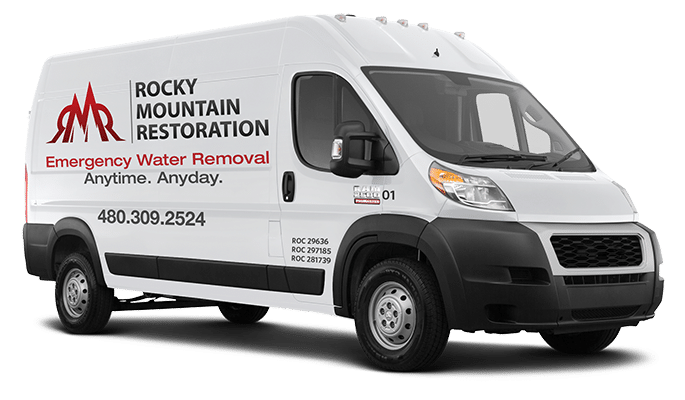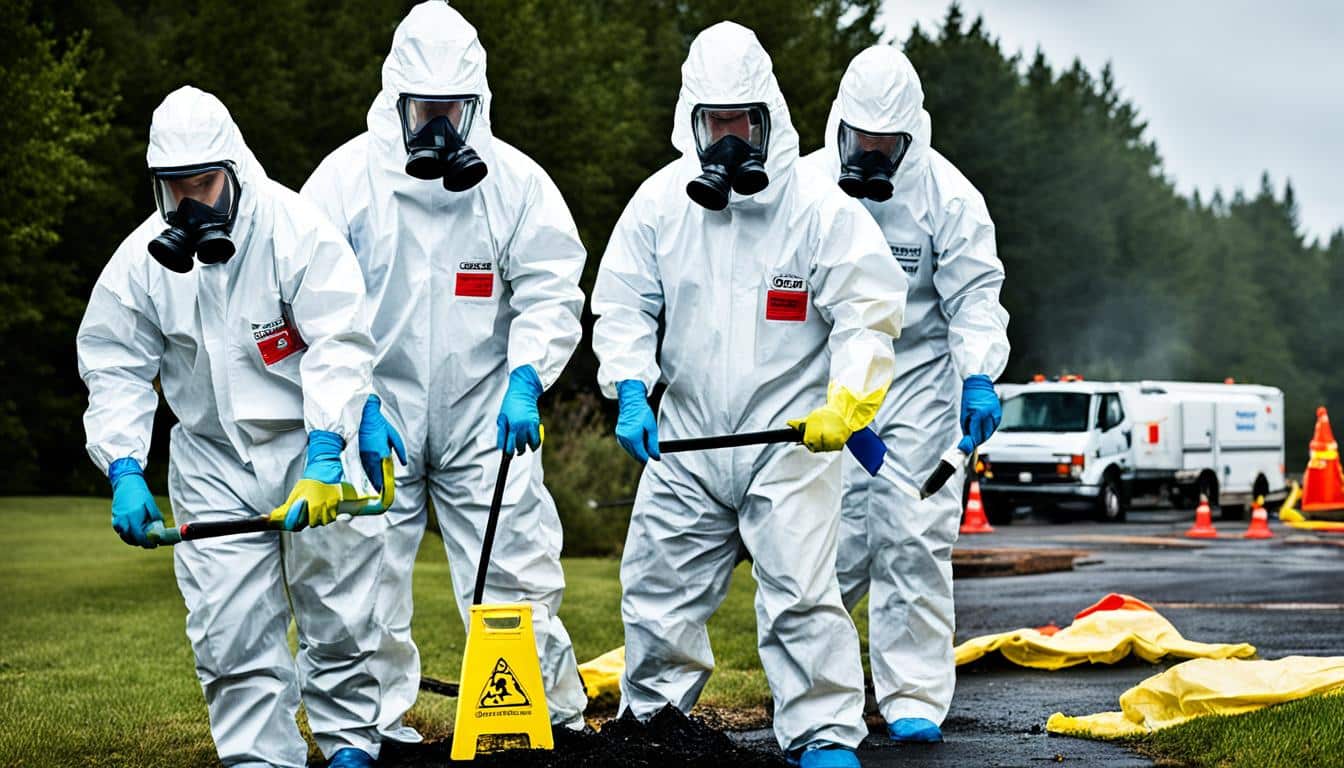When it comes to biohazard cleanup, there is more to it than meets the eye. It goes beyond just cleaning up a mess. But what exactly is included in the process? What steps are taken to ensure a thorough and safe remediation?
Whether it’s a crime scene, a chemical spill, or a traumatic accident, biohazard cleanup involves much more than your typical cleaning routine. It requires specialized knowledge, expertise, and meticulous attention to detail to handle and dispose of hazardous materials properly.
So, what does the process of biohazard cleanup entail? Let’s explore the steps involved and uncover what goes on behind the scenes to make an area safe and free from biohazards.
Key Takeaways:
- Biohazard cleanup involves the removal and remediation of harmful materials such as blood, bodily fluids, chemicals, and mold.
- The process follows strict guidelines from organizations like OSHA, EPA, and CDC to ensure safety and proper handling of biohazardous materials.
- Biohazard cleanup can vary based on the situation but often requires specialized equipment and personal protective gear.
- The steps in the process include identification and assessment, setup of a controlled environment, removal of infectious materials, thorough cleaning and decontamination, proper disposal of hazardous waste, and restoration of the property.
- Hiring professionals for biohazard cleanup is essential to ensure effective and safe remediation.
What are Biohazard Materials and their Categories?
Biohazard materials are biological substances that possess the potential to spread disease and pose a threat to health. These materials include microorganisms, plants, animals, and their byproducts. Biohazardous substances can range from human bodily fluids to animal waste, medical waste, pathological waste, and mold and fungi. It is crucial to understand the categories in which biohazard materials are classified, as they help determine the appropriate precautions and safety measures required for handling and disposal.
The categorization of biohazards is based on several factors, including the level of risk, infectivity, severity of disease, transmissibility, and the nature of the work conducted. There are four levels of biohazard categories:
- Level 1: This category includes biohazards that pose a minimal risk to both the workers and the community. They typically do not cause severe disease in healthy individuals, and effective preventive measures are available. Examples of Level 1 biohazards include non-infectious bacteria and viruses.
- Level 2: Level 2 biohazards present a moderate risk and have the potential to cause human disease. While they may not spread easily, they can still lead to significant health implications. Examples of Level 2 biohazards include HIV, hepatitis B, salmonella, and influenza.
- Level 3: This category comprises biohazards that can cause serious or potentially lethal diseases. These diseases may be transmitted through respiratory routes and can pose a significant risk to individuals in certain occupational settings. Examples of Level 3 biohazards include tuberculosis, SARS-CoV-2 (the virus responsible for COVID-19), and hantavirus.
- Level 4: Level 4 biohazards encompass highly dangerous and exotic agents that pose a severe threat to public health. These agents are often life-threatening, lack effective treatments or vaccines, and require the highest level of containment measures. Examples of Level 4 biohazards are Ebola virus, Marburg virus, and Lassa fever virus.
Understanding the categories of biohazard materials is crucial for ensuring the appropriate precautions are taken when handling, storing, and disposing of these hazardous substances. By adhering to proper protocols and safety measures, the risks associated with biohazards can be effectively mitigated, protecting the health and well-being of individuals and communities.
Common Biohazard Situations Requiring Cleanup
Professional cleanup is necessary in various common biohazard situations. These situations encompass a range of hazardous materials and scenarios that pose risks to individuals and the environment. Proper cleanup and remediation are crucial to ensure safety and prevent the spread of disease. The following are examples of common biohazard situations that require professional attention:
- Cleaning up blood and bodily fluid residue: Accidents, injuries, and medical procedures can result in the presence of blood and bodily fluids. Professional cleanup is necessary to safely remove and dispose of these biohazardous materials.
- Removing animal waste or remains: Animal waste, such as urine, feces, or carcasses, can contain harmful bacteria and parasites. Proper cleanup is essential to prevent the spread of disease and maintain a healthy environment.
- Addressing hoarding situations: Hoarding can lead to excessive clutter and unsanitary conditions. Biohazard cleanup is required to restore safety, remove hazardous materials, and mitigate health risks associated with hoarded items.
- Dealing with suicide or death scenes: Biohazard cleanup is necessary after incidents involving suicide, homicide, or unattended deaths. This ensures the thorough removal of bodily fluids, blood, and decomposition remnants.
- Handling crime scenes: Crime scenes often involve biohazard materials like blood, DNA, and other bodily fluids. Professional cleanup is crucial to protect investigators, prevent cross-contamination, and restore the scene to a safe condition.
- Managing chemical hazards: Chemical spills or leaks require specialized cleanup procedures to minimize exposure and prevent environmental contamination. Professional biohazard cleanup ensures proper handling, containment, and disposal of hazardous chemicals.
- Addressing virus contamination or disease outbreaks: Biohazard cleanup is essential during virus outbreaks, pandemics, or infectious disease situations. Thorough disinfection and decontamination protocols are followed to mitigate the risk of transmission.
- Addressing sewage contamination: Sewage backups or leaks can introduce harmful bacteria, viruses, and parasites into the environment. Professional cleanup is necessary to safely remove sewage, disinfect the area, and restore hygiene.
- Remedying mold or fungus infestations: Mold and fungus can thrive in damp, poorly ventilated environments, causing health hazards and structural damage. Professional cleanup addresses mold growth, removes affected materials, and implements remediation measures to prevent recurrence.
Each biohazard situation requires specific protocols and procedures to ensure thorough cleanup and remediation. Hiring professional biohazard cleanup services is crucial to properly address these situations, protect individuals from potential health risks, and restore the affected areas to a safe and habitable condition.
The Process of Biohazard Cleanup
Biohazard cleanup is a meticulous process that follows a series of steps to ensure thorough remediation. Each step is crucial to effectively eliminate the biohazardous materials and restore the affected area to a safe and clean state.
Step 1: Identification and Assessment
The first step in the biohazard cleanup process is to identify and assess the areas that have been affected. This involves determining the extent of contamination and the specific biohazard materials present. A thorough assessment helps create a comprehensive plan for cleanup and remediation.
Step 2: Setup of Control Room or Clean Space
After the assessment, a control room or clean space is set up to ensure safe entry and exit during the cleanup process. This area serves as a designated zone for the storage of equipment, personal protective gear, and decontamination procedures.
Step 3: Removal of Visible Damage and Infectious Materials
The cleanup team carefully removes any visible damage and potentially infectious materials from the affected area. This can include the disposal of contaminated items, such as furniture, carpets, or other porous materials, to prevent the spread of biohazards.
Step 4: Cleaning and Decontamination
The next step involves thorough cleaning and decontamination of the entire area using specialized cleaning agents and equipment. This process ensures the removal of any remaining biohazardous substances and the elimination of harmful pathogens.
Step 5: Disposal of Hazardous Waste
All biohazardous waste generated during the cleanup process is disposed of according to strict regulations and guidelines. Proper disposal methods are followed to prevent any further contamination and to protect public health and the environment.
Step 6: Sanitization and Deodorization
To ensure a safe and clean environment, the air is thoroughly sanitized and deodorized. This helps remove any lingering odors and eliminates any potential microorganisms that may still be present.
Step 7: Stain Sealing and Restoration
Finally, any remaining stains on walls and flooring are sealed to prevent further contamination and to restore the appearance of the affected area. In some cases, damaged materials may need to be removed and replaced to complete the restoration process.
The process of biohazard cleanup requires expertise, specialized equipment, and strict adherence to safety protocols. Hiring a professional biohazard cleanup company ensures that the cleanup process is conducted efficiently and effectively, minimizing the risk of exposure to harmful biohazards.
| Step | Description |
|---|---|
| Identification and Assessment | Determine the extent of contamination and specific biohazard materials present. |
| Setup of Control Room or Clean Space | Create a designated zone for storage of equipment and decontamination procedures. |
| Removal of Visible Damage and Infectious Materials | Safely dispose of contaminated items and materials to prevent the spread of biohazards. |
| Cleaning and Decontamination | Thoroughly clean and decontaminate the affected area using specialized cleaning agents and equipment. |
| Disposal of Hazardous Waste | Dispose of biohazardous waste in accordance with regulations and guidelines. |
| Sanitization and Deodorization | Sanitize and deodorize the air to eliminate pathogens and odors. |
| Stain Sealing and Restoration | Seal remaining stains and restore the appearance of the affected area. |
Conclusion
The process of biohazard cleanup is of utmost importance when it comes to ensuring the safety of individuals and the environment. It requires specialized knowledge, equipment, and expertise to thoroughly remove and remediate harmful materials. Professional biohazard cleanup companies adhere to strict guidelines and regulations set forth by organizations such as OSHA, EPA, and CDC to handle and dispose of biohazardous materials in a safe and proper manner.
Hiring professionals for biohazard cleanup is essential for effective and safe remediation. These experts have the necessary training and experience to handle even the most challenging cleanup situations, such as crime scenes, hoarding situations, or mold infestations. They possess the appropriate equipment and personal protective gear to ensure their own safety while carrying out the cleanup process.
In addition to their technical expertise, professional biohazard cleanup companies provide support and empathy during traumatic situations. They understand the emotional toll that these events can have on individuals and families and approach their work with compassion and sensitivity. By entrusting the cleanup to professionals, individuals can focus on healing and moving forward without the added burden of handling the cleanup themselves.
Call Rocky Mountain Restoration today at (480) 309-2524 for professional biohazard cleanup services!
FAQ
What is included in the process of biohazard cleanup?
Biohazard cleanup involves removing and remediating harmful materials such as blood, bodily fluids, chemicals, mold, and more. It includes cleaning and sanitizing areas where accidents, injuries, or deaths have occurred. The process follows guidelines from OSHA, EPA, and CDC and involves proper handling and disposal of biohazardous materials.
What are biohazard materials and their categories?
Biohazard materials include biological substances like microorganisms, plants, animals, and their byproducts that have the potential to spread disease and pose a threat to health. Biohazards are categorized into four levels based on their level of risk, infectivity, severity of disease, transmissibility, and the nature of the work conducted.
What are the common biohazard situations that require cleanup?
The common biohazard situations requiring professional cleanup include cleaning up blood and bodily fluid residue, removing animal waste or remains, addressing hoarding situations, dealing with suicide or death scenes, handling crime scenes, managing chemical hazards, addressing virus contamination or disease outbreaks, addressing sewage contamination, and remedying mold or fungus infestations.
What is the process of biohazard cleanup?
The process of biohazard cleanup includes identifying and assessing the affected areas, setting up a control room or clean space, removing visible damage and infectious materials, cleaning and decontaminating the area, disposing of hazardous waste, sanitizing and deodorizing the air, and sealing any remaining stains on walls and flooring.
Why is professional biohazard cleanup important?
Biohazard cleanup is a critical process that requires specialized knowledge, equipment, and expertise. Hiring professionals for biohazard cleanup ensures effective and safe remediation while providing support and empathy during traumatic situations.













